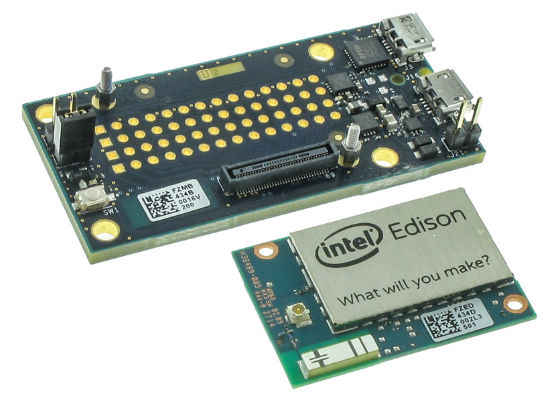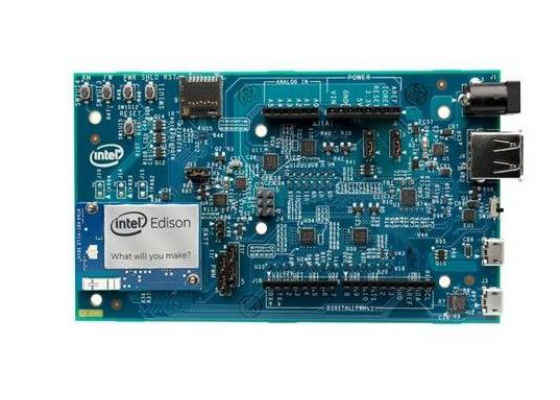When to Use the Intel Edison Board

The Internet is a powerful platform for many technological advancements. Now, you can connect embedded systems over the Internet to form large networks for monitoring and controlling operations from a centralized location. A lot of open source hardware has been designed to allow embedded system programmers to harness the power of the Internet of Things (IoT). The Intel® Edison Module is a good example of such hardware (Figure 1).
 Survey
SurveyFigure 1. The Intel® Edison board is designed for wireless projects.
The Intel® Edison board is based on the Intel® Atom™ Z34XX chip. It’s designed to be the perfect hardware for your wireless projects, whether you’re using Bluetooth* or Wi-Fi. The Intel® Edison board has more processing power than most other open source boards, but is comparatively smaller in size. You can accomplish a lot with it this board if you know when and where to use it. So, let’s look at a few instances where it’s ideal to use the Intel® Edison board.
Running Heavy Server-Side Applications
You can use any development board that has Wi-Fi capabilities for small-scale IoT projects because such projects don’t require heavy server-side applications, but if you want to build an elaborate system, such as a wireless image-recognition platform, or monitor operations at a huge facility, you need a powerful IoT board such as the Intel® Edison board. It can run server-side applications that require a lot of computing power. Even when devices can communicate with powerful servers in data centers, some tasks, like facial recognition, are best done locally on the board.
By default, the Intel® Edison board uses the Yocto Project* Linux* operating system, and can support powerful server-side applications, because it uses frameworks such as Node.js*. Node.js is a powerful runtime environment for developing server-side web applications. With Node.js and Intel® XDK, you can create applications to control and monitor the Intel® Edison board using a web interface. This ability to run as a lightweight client (to send data to a remote web server, for example) but also to function as a server that can run applications is the strength of the Intel® Edison board.
In addition to running Node.js, the Intel® Edison board has a powerful dual-core Intel® Atom™ Z34XX processor with a high clock speed. This gives it enough power to run complex applications efficiently and eliminates the issues that arise from timeout errors, such as loss of valuable data. The board also has ample space for data storage. The 4 GB of internal storage space is more than enough for web apps and other related files. Moreover, the board’s 1 GB of RAM is adequate for handling runtime data.
Space Constraints
The Intel® Edison board is small in size—approximately 35 mm by 25 mm by 3.9 mm—so you can easily fit it in your project without making huge changes to the design of the enclosure. The small form factor makes the Edison board ideal for portable projects and wearables.
Interacting With the Intel Family of Boards
Interacting with other Intel boards, like the Intel® Galileo board, is easy when you use the Intel® Edison board. No external hardware is needed because all the Intel boards operate with the same logic voltage of 1.8 V. The same does not apply when you’re using the Intel® Edison board with other boards and Arduino* shields, however, because most of them operate at a logic voltage of 3.3 V or 5 V. To use the Intel® Edison
board with other boards, such as Arduino boards or the Raspberry Pi* board, you might have to use an interface board that has level shifters.
Wireless Communication
The Intel® Edison board is one of the few boards available that have both integrated Wi-Fi and Bluetooth low energy features. It has an on-board Broadcom* CM43340 BT/Wi-Fi chip that allows the board to communicate over Wi-Fi and Bluetooth 4.0. Therefore, it’s the best board to use in applications that require wireless monitoring and control, such as wireless logging of sensor data.
Using Arduino* Shields
If you have a project on which you need to use an Arduino shield, don’t shy away from the Edison board. The Intel® Edison Kit for Arduino acts as an expansion board for the Intel® Edison board (Figure 2). The kit has a pin configuration compatible with the Arduino UNO R3 pin configuration and is fitted with level shifting circuits that convert the logic voltage of the Intel® Edison board to that of the shield mounted on the kit. You can mount any UNO R3 shield on the kit and control it directly from the board: The kit creates a direct connection between the board and the shield, increasing the scope of projects that you can create with the Edison board.
Figure 2. The Intel® Edison Kit for Arduino* makes the Edison board compatible with Arduino shields.
Programming Versatility
You can program the Intel® Edison board, like other Intel boards, using different development tools. Common tools include Intel® XDK, the Arduino integrated development environment, and Wind River Rocket*. This range is an important feature: Every tool has its own strengths, so you can choose the right tool to maximize the potential of the Intel® Edison board in your projects.
In addition, you can choose from a wide range of programming languages for the Intel® Edison board, including C, C++, Python*, JavaScript*, HTML5, and Perl. Which programming language you use depends on the development tool you select. Some tools allow programming in different languages, so you don’t necessarily have to learn a new language to program the board.
For more such intel IoT resources and tools from Intel, please visit the Intel® Developer Zone
Source: https://software.intel.com/en-us/articles/when-to-use-the-intel-edison-board

